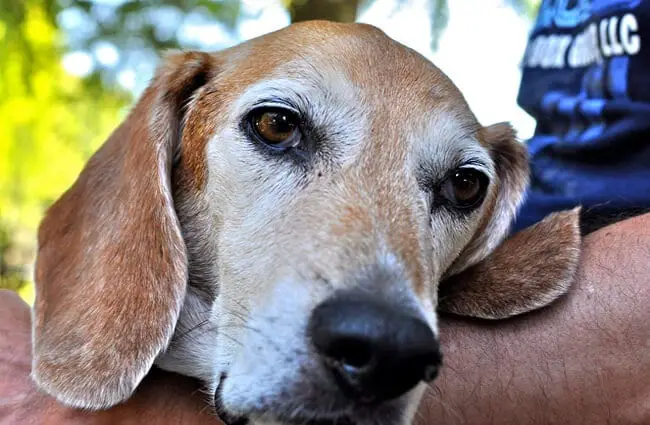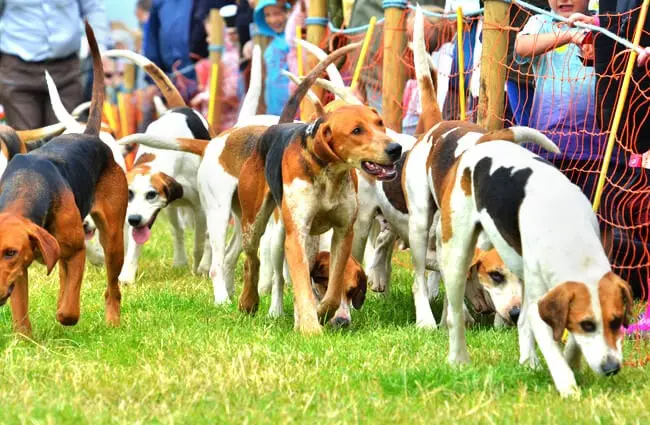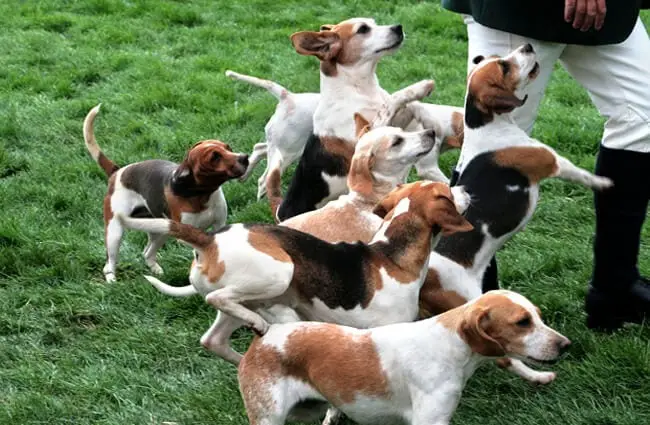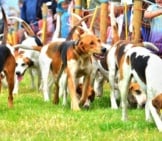The Harrier is the larger and leaner cousin of the Beagle. These pack hounds are excellent hunters and are able to withstand long days on the trail. But they have all the amiable qualities of a hound, like patience and a mellow nature, which makes them such great home companions. You can expect a great adventure companion in this breed. Read on to learn more about the Harrier.
Description of the Harrier
Some like to describe the Harrier as what a Beagle would look like if it went to the gym. The is no denying the effortless grace that comes from this sinewy and well-built dog.
Their hound blood gives them many of the personality and physical characteristics that are so typical of this group. They have long and incredibly soft ears, a sweet and pleading expression, a gentle attitude at home and a tough one on the trail, and a substantial muzzle.
The Harrier is a rarer breed, but they are quite popular among their fans. Breeders first conceived of these dogs in medieval England to hunt hares, and this is where their name comes from.
Like many hounds, the Harrier has a short, dense, and glossy coat. They come in all variety of colors, which makes for some truly beautiful dogs!
Life Expectancy and Size
While the Harrier does have certain health problems that are prevalent in the bred, most go on to live a full life that is 12 – 15 years. Working with a breeder can help prevent some genetic problems that may shorten their lives or be costly to deal with.
Bigger than a Beagle but small than the English Foxhound from which they received their original genes, the Harrier stands 19 – 21 inches tall and weighs 45 – 60 pounds.
Protective Ability
The Harrier is a pack dog and so they bond closely with their families, but if you think this means they will be protective, think again. While they can be alert watchdogs, the Harrier is so friendly with everyone he meets he will be eager to greet anyone who comes to the door. But this friendliness is a great quality of this breed and will make you love him even more.
Training
It is true that the Harrier is an outgoing and eager to learn breed, but they often have some houndy independence and require patience, consistency, and kindness to learn.
Positive rewards-based methods are the best way forward with this breed. Treats are especially effective with this food-oriented dog. They are highly motivated by treats and will be even more eager to listen to you when they know a tasty reward is on the line.
Consistency is also essential for this breed. They want to learn but are quick to pick up bad habits if there is no consistency in their training. Make sure everyone in the house knows what words or actions to use for training so your Harrier doesn’t get confused.
Early socialization is also a wonderful opportunity for this breed. Introducing your dog to many different people and dogs, and exposing him to various situations will help your Harrier develop into a well-mannered pup.
Energy Level
As with most hounds, the Harrier has energy that comes in spurts. They tend to lounge around and sleep for parts of the day, but when they are ready to go you will know it! They have plenty of energy that must be exercised through hunting, long walks, backyard playtime, or canine sports.
Sedentary families may find the energy of the Harrier more than they are ready for. While they can make excellent snuggle buddies, these dogs’ breeding means they need to run for hours, and to get plenty of exercise every day.
What Living with a Harrier is Like
This is an all-around kind breed.
They are great with families, children, and other dogs. The patient nature of the Harrier is well adapted to many different types of situations and they are easy-going and even-tempered. Active families and hunters will find a perfect companion in this athletic breed.
While these dogs do love their down time, sedentary families should be mindful that their energy far outweighs their laziness. These dogs require lots of physical and mental stimulation every day to be happy.
Care of the Harrier
These dogs are quite versatile, but do best in a home where they can run around and get plenty of exercise and affection.
Environmental Needs
Adaptable to most weather, the Harrier is a hardy breed that easily adjusts to rough terrain and inclement conditions. They are a bit more tolerant of hot weather, so consider investing in a jacket for your dog if he is to spend a lot of time in cold weather.
Exercise Needs
Ample exercise broken up by plenty of naps is great for this breed. They love to move and snuggle their family so be prepared for both. At least an hour of exercise a day will make sure your Harrier is happy and healthy. Hunting, long walks or jogs, backyard playtime and canine sports are all great ways to work out your dog.
Shedding and Grooming
The short coat of the Harrier is quite easy to maintain. A weekly brush should be enough to keep your dog’s coat looking glossy.
This breed sheds some, but not heavily.
Regularly cleaning your dog’s ears is one of the more important elements of their hygiene. Ear infections are common in this breed’s long floppy ears.
Ideal Home Environment
An affectionate and active home is a great choice for this breed. So long as they get love and plenty of exercise these dogs can do well anywhere. City living may be too tough for the Harrier, as they need a big fenced in yard to run around.
Health Concerns
The biggest concern for the Harrier is hip dysplasia. Working with a reputable breeder can help prevent this problem in your dog. Other issues include ear infections and oral problems. Regularly clean your dog’s ears and brush his teeth to avoid these potential issues.
Behavior Problems
These scent-oriented dogs are quick to chase after anything they think is prey. Keep them fenced in or on leash to prevent them from running off.
Separation anxiety is another concern for this pack dog. They love companionship so early socialization and plenty of daily interaction are a must for this breed.




















![Red Angus Closeup of a beautiful Red Angus cowPhoto by: U.S. Department of Agriculture [pubic domain]https://creativecommons.org/licenses/by/2.0/](https://animals.net/wp-content/uploads/2020/03/Red-Angus-4-100x75.jpg)

